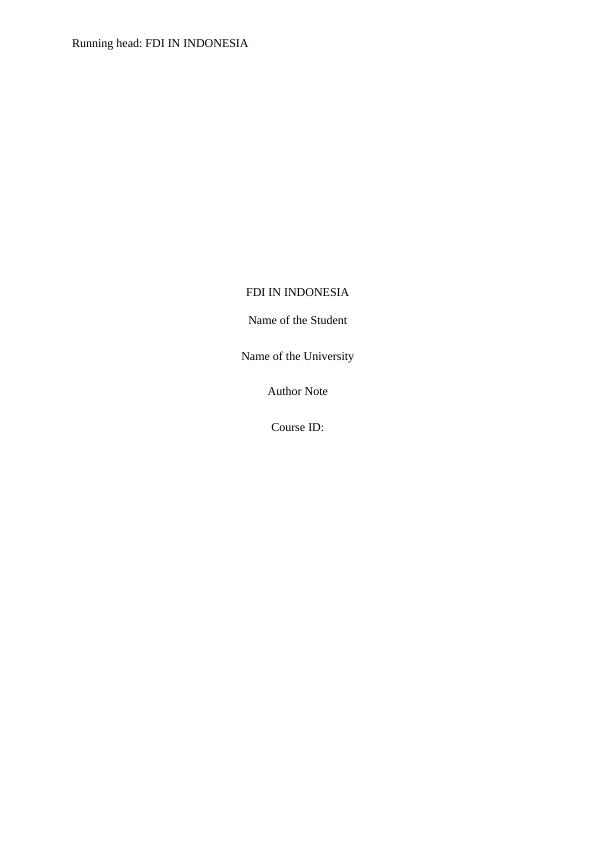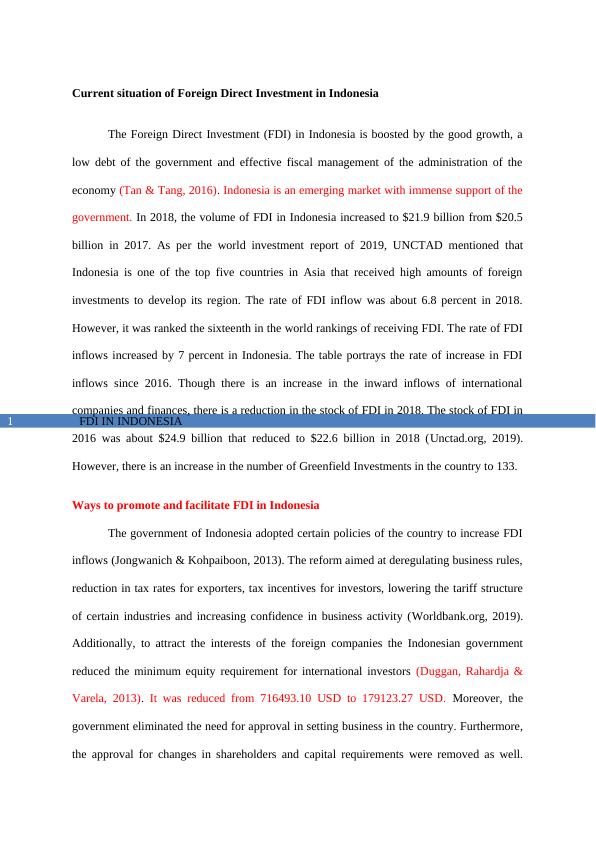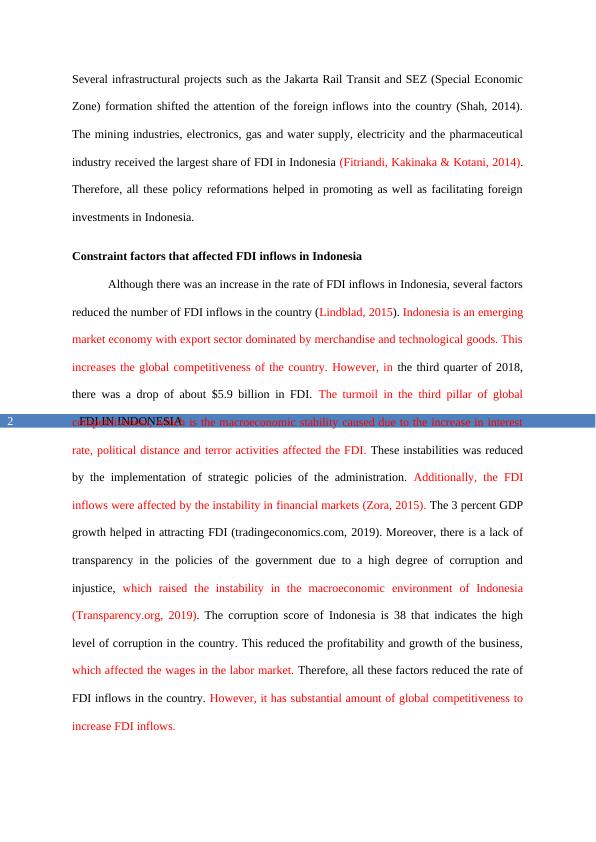Foreign Direct Investment in Indonesia
Added on 2022-09-12
7 Pages1396 Words38 Views
Running head: FDI IN INDONESIA
FDI IN INDONESIA
Name of the Student
Name of the University
Author Note
Course ID:
FDI IN INDONESIA
Name of the Student
Name of the University
Author Note
Course ID:

FDI IN INDONESIA1
Current situation of Foreign Direct Investment in Indonesia
The Foreign Direct Investment (FDI) in Indonesia is boosted by the good growth, a
low debt of the government and effective fiscal management of the administration of the
economy (Tan & Tang, 2016). Indonesia is an emerging market with immense support of the
government. In 2018, the volume of FDI in Indonesia increased to $21.9 billion from $20.5
billion in 2017. As per the world investment report of 2019, UNCTAD mentioned that
Indonesia is one of the top five countries in Asia that received high amounts of foreign
investments to develop its region. The rate of FDI inflow was about 6.8 percent in 2018.
However, it was ranked the sixteenth in the world rankings of receiving FDI. The rate of FDI
inflows increased by 7 percent in Indonesia. The table portrays the rate of increase in FDI
inflows since 2016. Though there is an increase in the inward inflows of international
companies and finances, there is a reduction in the stock of FDI in 2018. The stock of FDI in
2016 was about $24.9 billion that reduced to $22.6 billion in 2018 (Unctad.org, 2019).
However, there is an increase in the number of Greenfield Investments in the country to 133.
Ways to promote and facilitate FDI in Indonesia
The government of Indonesia adopted certain policies of the country to increase FDI
inflows (Jongwanich & Kohpaiboon, 2013). The reform aimed at deregulating business rules,
reduction in tax rates for exporters, tax incentives for investors, lowering the tariff structure
of certain industries and increasing confidence in business activity (Worldbank.org, 2019).
Additionally, to attract the interests of the foreign companies the Indonesian government
reduced the minimum equity requirement for international investors (Duggan, Rahardja &
Varela, 2013). It was reduced from 716493.10 USD to 179123.27 USD. Moreover, the
government eliminated the need for approval in setting business in the country. Furthermore,
the approval for changes in shareholders and capital requirements were removed as well.
Current situation of Foreign Direct Investment in Indonesia
The Foreign Direct Investment (FDI) in Indonesia is boosted by the good growth, a
low debt of the government and effective fiscal management of the administration of the
economy (Tan & Tang, 2016). Indonesia is an emerging market with immense support of the
government. In 2018, the volume of FDI in Indonesia increased to $21.9 billion from $20.5
billion in 2017. As per the world investment report of 2019, UNCTAD mentioned that
Indonesia is one of the top five countries in Asia that received high amounts of foreign
investments to develop its region. The rate of FDI inflow was about 6.8 percent in 2018.
However, it was ranked the sixteenth in the world rankings of receiving FDI. The rate of FDI
inflows increased by 7 percent in Indonesia. The table portrays the rate of increase in FDI
inflows since 2016. Though there is an increase in the inward inflows of international
companies and finances, there is a reduction in the stock of FDI in 2018. The stock of FDI in
2016 was about $24.9 billion that reduced to $22.6 billion in 2018 (Unctad.org, 2019).
However, there is an increase in the number of Greenfield Investments in the country to 133.
Ways to promote and facilitate FDI in Indonesia
The government of Indonesia adopted certain policies of the country to increase FDI
inflows (Jongwanich & Kohpaiboon, 2013). The reform aimed at deregulating business rules,
reduction in tax rates for exporters, tax incentives for investors, lowering the tariff structure
of certain industries and increasing confidence in business activity (Worldbank.org, 2019).
Additionally, to attract the interests of the foreign companies the Indonesian government
reduced the minimum equity requirement for international investors (Duggan, Rahardja &
Varela, 2013). It was reduced from 716493.10 USD to 179123.27 USD. Moreover, the
government eliminated the need for approval in setting business in the country. Furthermore,
the approval for changes in shareholders and capital requirements were removed as well.

FDI IN INDONESIA2
Several infrastructural projects such as the Jakarta Rail Transit and SEZ (Special Economic
Zone) formation shifted the attention of the foreign inflows into the country (Shah, 2014).
The mining industries, electronics, gas and water supply, electricity and the pharmaceutical
industry received the largest share of FDI in Indonesia (Fitriandi, Kakinaka & Kotani, 2014).
Therefore, all these policy reformations helped in promoting as well as facilitating foreign
investments in Indonesia.
Constraint factors that affected FDI inflows in Indonesia
Although there was an increase in the rate of FDI inflows in Indonesia, several factors
reduced the number of FDI inflows in the country (Lindblad, 2015). Indonesia is an emerging
market economy with export sector dominated by merchandise and technological goods. This
increases the global competitiveness of the country. However, in the third quarter of 2018,
there was a drop of about $5.9 billion in FDI. The turmoil in the third pillar of global
competitiveness, which is the macroeconomic stability caused due to the increase in interest
rate, political distance and terror activities affected the FDI. These instabilities was reduced
by the implementation of strategic policies of the administration. Additionally, the FDI
inflows were affected by the instability in financial markets (Zora, 2015). The 3 percent GDP
growth helped in attracting FDI (tradingeconomics.com, 2019). Moreover, there is a lack of
transparency in the policies of the government due to a high degree of corruption and
injustice, which raised the instability in the macroeconomic environment of Indonesia
(Transparency.org, 2019). The corruption score of Indonesia is 38 that indicates the high
level of corruption in the country. This reduced the profitability and growth of the business,
which affected the wages in the labor market. Therefore, all these factors reduced the rate of
FDI inflows in the country. However, it has substantial amount of global competitiveness to
increase FDI inflows.
Several infrastructural projects such as the Jakarta Rail Transit and SEZ (Special Economic
Zone) formation shifted the attention of the foreign inflows into the country (Shah, 2014).
The mining industries, electronics, gas and water supply, electricity and the pharmaceutical
industry received the largest share of FDI in Indonesia (Fitriandi, Kakinaka & Kotani, 2014).
Therefore, all these policy reformations helped in promoting as well as facilitating foreign
investments in Indonesia.
Constraint factors that affected FDI inflows in Indonesia
Although there was an increase in the rate of FDI inflows in Indonesia, several factors
reduced the number of FDI inflows in the country (Lindblad, 2015). Indonesia is an emerging
market economy with export sector dominated by merchandise and technological goods. This
increases the global competitiveness of the country. However, in the third quarter of 2018,
there was a drop of about $5.9 billion in FDI. The turmoil in the third pillar of global
competitiveness, which is the macroeconomic stability caused due to the increase in interest
rate, political distance and terror activities affected the FDI. These instabilities was reduced
by the implementation of strategic policies of the administration. Additionally, the FDI
inflows were affected by the instability in financial markets (Zora, 2015). The 3 percent GDP
growth helped in attracting FDI (tradingeconomics.com, 2019). Moreover, there is a lack of
transparency in the policies of the government due to a high degree of corruption and
injustice, which raised the instability in the macroeconomic environment of Indonesia
(Transparency.org, 2019). The corruption score of Indonesia is 38 that indicates the high
level of corruption in the country. This reduced the profitability and growth of the business,
which affected the wages in the labor market. Therefore, all these factors reduced the rate of
FDI inflows in the country. However, it has substantial amount of global competitiveness to
increase FDI inflows.

End of preview
Want to access all the pages? Upload your documents or become a member.
Related Documents
Global and International Business Contexts: Indonesialg...
|18
|6302
|437
Overview of Indonesia's Economy, Trade and Investment Opportunitieslg...
|14
|1123
|301
China’s Economic Growth Assignment PDFlg...
|4
|886
|107
China's Business Environment: A PESTEL Analysislg...
|5
|1533
|197
FDIs and Country Attractiveness in Vietnam - UNCTADlg...
|6
|1387
|274
Tax Deductions and FDI in India and Bangladeshlg...
|2
|1177
|342
